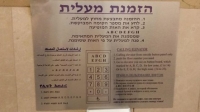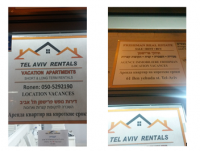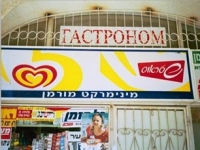|
To learn a foreign language is to have one more window to the world.
(Chinese Proverb)
Linguistic Landscape
The structure and systematicity of languages in the environment around us can be inspected through the lens of linguistic landscape (henceforth LL) (Landry and Bhouris, 1979). LL refers to the visibility of languages on objects which structure the public space in a given territory and is comprised of: road signs; names of sites, streets, buildings, places, and institutions; billboards; commercials; business cards; fashion items, such as T-shirts and tote bags carrying a written message; financial information related to money and currencies. LL includes both public signs, issued by governmental authorities and public agencies often limited by national language policies (Huebner 2006); and private signs, issued by individuals, associations, and businesses. LL also serves as a window to the sociolinguistic makeup of a geographical area and reflects the linguistic preferences of a community of speakers. Browsing the linguistic display around us is a way to unwrap social matters, such as the identities of the inhabitants of a certain area and the relative power and status of the linguistic communities inhabiting this area.
The LL of Israel in a Nutshell
The multiethnic and multilingual set-up of Israel is well-represented by the degree of visibility of Hebrew, Arabic, and English and of other languages on private and public signs (Spolsky and Cooper, 1991; Ben Rafael et. al., 2006; Trumper-Hecht, 2009). One can find different messages behind the choice of languages on display. Power relations are revealed through languages of predominance and secondary importance. Governmental offices may choose to display instructions in the languages spoken by the public they serve: the elevator of the government office-building in Haifa has instructions in five languages: Hebrew, English, Russian, Arabic, and Amharic (see Picture 1). Individuals give expressions to their identity through the choice of shirts they are wearing (see Picture 2). Businesses disclose commercial interests by choosing languages they exhibit on their signs and advertisements which, they hope, may attract potential clients who are speakers of a given language. For example, walking down Ben Yehuda Street in Tel Aviv, one is inundated by the mass of real estate ads in French, reflecting the target French-speaking customers (see Picture 3). On the other hand, a local minimarket in a neighborhood inhabited by Russian speakers would likely have signs in Russian (see Picture 4).
|

Picture 1 (Source: taken by author) |

Picture 2 (Source: taken by author) |
|

Picture 3 (Source: taken by author) |

Picture 4 (Source: taken by author) |
Ben Rafael et. al. (2006) note that English is gaining growing importance in contemporary Israel especially in middle and upper-class areas. Brand names of clothing exemplify this spreading reality. In the globalized world, English acts as a genuine status marker, and its use entails prestige. In today’s Israel, we buy into this image: global brands are especially popular, most of which display their wares in the English language.
Using LL for ELT Purposes
Taking the language learning experience beyond the walls of the classroom, thereby making learning multidimensional, inspires better learning and retention. By using LL, not only can we develop students’ linguistic repertoire, but we can also educate a more aware and socially-responsible generation. LL can be used in the classroom to raise awareness of our environment’s linguistic richness and stress the diversity of languages. Together with our students, we could examine the frequency and ratio between home and foreign languages. Analyzing LL develops critical thinking: students could compare and contrast the types of signs, the presence/absence of languages, notice patterns, ask questions, and inspect the why-s of the current situation, thus fostering critical thinking. Furthermore, using LL we can teach language content, names of languages, cognates, and vocabulary related to linguistic landscape (signs, ads, bulletin boards, etc.) as well as the skills of describing, comparing, and contrasting.
Teachers could assign their students projects through which they investigate the topic of LL, gather information from their surroundings, and understand the implications of the findings. Such projects are an excellent way of practicing language content and implementing higher-order thinking skills. By sharing their findings students can also fine-tune their presentation skills.
Below is a sample of suggested LL-themed activities, developed by English teachers in Israel in the framework of an in-service professional development course delivered by the author of this article.
ABC in the supermarket. This activity is suitable for starting learners in elementary grades. Students must recognize brands such as Coca-Cola, Oreo, Pringles, etc. in the supermarket and write them down having mastered the alphabet. Whoever finds the most items is the winner!
A multicultural restaurant in your classroom. This activity is suitable for elementary and intermediate levels. Students are required to gather information about the language and food names and descriptions displayed in menus either by searching the internet or exploring local restaurants to collect different types of food. Students learn about the origin of food names (e.g. pizza- Italian, croissant-French, pirozhki-Russian, etc.). Together they construct menus and act out restaurant situations in English.
Christmas in Nazareth. This activity is suitable for learners at the intermediate and advanced level and fosters an appreciation of other cultures. Students of different backgrounds, cultures, higher-order, and faiths are exposed to vocabulary related to Christmas and New Year’s Eve. They learn about the wording and the layout of greeting cards. Upon visiting Nazareth, a group of students visits shops to study the language used in cards. Another group looks for language in various food ads related to the winter holidays. A third group studies the LL of hotels and halls and churches designated for Christmas celebrations. Following the field trip, students present and discuss their findings.
In conclusion, the educational applications of LL are boundless. Involving the students in a more participatory role in exploring, analyzing, and criticizing the language situations of their surroundings can increase their awareness of social justice. I hope that this piece has ignited some inspiration in you to try out one of the above suggestions or even create your linguistic landscape activities.
References
Ben-Rafael, Eliezer, Elana Shohamy, Amara Muhammad and Nira Trumper-Hecht. (2006). Linguistic Landscape as Symbolic Construction of the Public Space: The Case of Israel. International Journal of Multilingualism, 3, 7-30.
Huebner, Thom. (2006) Bangkok's linguistic landscapes: Environmental print,
codemixing, and language change. International journal of multilingualism, 3(1), 31-51.
Landry, Rodrigue and Richard Y. Bourhis. (1979). Linguistic landscape and ethnolinguistic vitality: An empirical study. Journal of language and social psychology 16(1), 23-49.
Spolsky, Bernard and Robert L. Cooper. (1991). The Languages of Jerusalem. Oxford: Clarendon Press.
Trumper-Hecht, Nira. (2009). Linguistic Landscape in mixed cities in Israel from the perspective of ‘Walkers’: The Case of Arabic. In: E.G. Shohamy, E. Ben Rafael, M. Barni (eds.) Linguistic Landscape in the City (pp. 235-251). Bristol: Multilingual Matters.
Biodata
Bridget Schvarcz is the chair of the English Teachers’ Association of Israel – a proud TESOL affiliate. She is the head of the English Unit at Afeka Academic College of Engineering and a teacher educator for the Israeli Ministry of Education, Department of Professional Development of Teaching Staff. Bridget is a Ph.D. candidate in linguistics at Bar-Ilan University. Her research interests are formal semantics, educational linguistics, teacher education, and language teacher identity. Her combined expertise in these fields has led her to design courses and conduct studies that integrate theoretical knowledge with classroom practice. |

